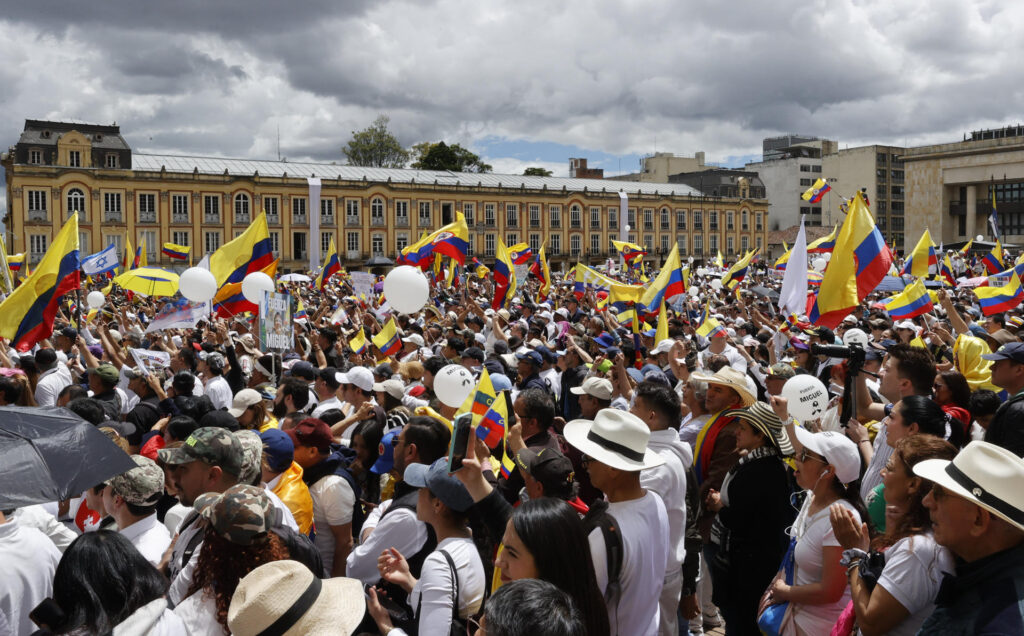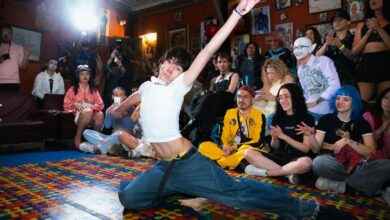Colombians Protest Calmly As Rebel Attacks Jolt Election Season

A slow tide of white shirts crept through Bogotá this weekend. No chants, no drums—only the scrape of shoes on stone and the rustle of roses. Their silence was a verdict on bullets that almost ended Miguel Uribe Turbay’s life and could yet wound Colombia’s fragile democracy.
From ICU Monitors to Cobblestones
Santa Fe Hospital still smelled of disinfectant when the first marchers gathered at dawn. Nurses on the seventh floor waved from windows, holding hand-drawn hearts for Sen. Miguel Uribe Turbay, who remains tethered to ventilators after the June 7 shooting that pierced his lung. Outside, volunteers placed baskets of white carnations next to a sign: “Take one, walk in silence.” Parents lifted toddlers onto their shoulders; elderly couples leaned on canes. No political banners were allowed—only placards reading “La vida es Sagrada“ and “Somos Miguel.“
The route wound thirty blocks down Séptima Avenue, skirting cafes where televisions once blared election debates. At each traffic light, marchers paused, letting latecomers fold into the current until the column stretched unbroken from hospital gates to Plaza de Bolívar. Shopkeepers stepped outside, some crossing themselves, others clapping softly as the quiet river passed. “It’s louder than fireworks,” whispered María Dolores, a florist who lost her cousin in last year’s Cauca car bomb. EFE counted more than 60,000 in Bogotá alone; smaller echoes rippled through Medellín, Bucaramanga, and a battered Cali still sweeping glass after three mid-week bomb blasts.
Ghosts From the Nineties Knock Again
Many who marched had lived this nightmare before. In 1989 and 1990, presidential hopefuls Luis Carlos Galán, Bernardo Jaramillo, and Carlos Pizarro fell to assassins’ bullets. Historian Gonzalo Sánchez, speaking to Caracol Radio, called last week’s attack “a grim déjà vu—proof our political arteries never fully healed.”
Security reports blame the latest violence on FARC dissidents under Iván Mordisco, men who rejected the 2016 peace accord and now tax cocaine routes through Cauca’s sugar-cane valleys. According to the government’s “Unidad de Víctimas,” 1,126 social leaders and politicians have been murdered since that treaty ink dried. One marcher, retired teacher Hilda García, carried a laminated list of eight civilians killed in Popayán and Corinto Tuesday night. “I refuse to memorize any more names,” she said, her cane thumping the pavement in time with her steps.
Analyst César Restrepo noted in Revista CIDOB that dissidents copy 1980s urban tactics: drive-by shootings, market-square grenades, and homemade mortars. Such attacks disrupt cities far from jungle hideouts, proving the state’s reach still ends before the gangs’ ambition does. Saturday’s white tide flowed partly in grief, partly in wrath: This cannot be the season replaying on a loop.

Politics at Boiling Point, Voices on Mute
President Gustavo Petro watched the march from Casa de Nariño, his popularity teetering as he defended an August referendum on labor reform that Congress has stalled. Opponents call the decree unconstitutional; allies brand it participatory democracy. That fault line was visible even in Saturday’s silence. Some carried discreet “Fuera Petro” flyers; others wore buttons quoting one of Petro’s tweet-storms about “the sacredness of life.”
Centrist figure Sergio Fajardo walked beside liberal ex-foreign minister María Ángela Holguín. Close behind, off-duty police veterans marched with victims’ mothers. Organizers begged everyone to leave slogans at home. Instead, the crowd recited the Apostles’ Creed, its soft Spanish rising like mist over Plaza de Bolívar’s colonial facades. When the last verse faded, they sang the national anthem—off-key but resolute—before dispersing without a shattered window or a spray-painted wall. Bogotá’s mayor, Carlos Fernando Galán, called it “the loudest hush this city has ever heard.”
Yet tension lingers—retired Maj. Gen. Eliécer Camacho told EFE that Petro’s “scorched-earth rhetoric” demonizes opponents and emboldens militants convinced the state is weak. Constitutional scholars at Universidad de los Andes warn that bypassing Congress could ignite provinces where dissident gunmen rule from dusk to dawn. The president, speaking late Saturday, praised the marchers’ restraint but insisted his referendum will proceed: “El pueblo debe decidir.”
Hope Wears White, Fear Never Sleeps
Night fell; candles flickered along Bolívar’s stone arcades. Volunteers collected wilted roses to press into books for Uribe Turbay’s children—memories, they said, of a day Colombians refused to scream back at bullets. But serenity feels provisional. Intelligence briefings leaked to El Tiempo predict more election-season attacks, particularly in Valle del Cauca, where contraband routes fork toward the Pacific.
Still, Saturday planted an alternative image: tens of thousands walking shoulder to shoulder, mouths closed, spines straight. Sociologist Alejandra Cruz told EFE the march evoked Gandhi’s salt protest—”silence weaponized against terror.” Back at Santa Fe Hospital, nurses wheeled Miguel Uribe past a window so he could glimpse a still-gathered knot of supporters. Tubes clouded his vision, but aides say he lifted two fingers in a half-formed peace sign.
Whether Colombia can match that gesture with lasting security will define the run-up to 2026. For now, the memory of white shirts sliding through Bogotá’s twilight offers a fragile counter-melody to Kalashnikov bursts—proof that a country soaked in decades of noise can still choose to whisper, together, “No more.”
Also Read: Carandiru Still haunts Brazil and its Prisons Keep Breeding the Same Violence
Credits: On-the-ground accounts and quotes courtesy of EFE correspondents in Bogotá and Cali; historical data from Universidad Nacional de Colombia archives; security analysis by Revista CIDOB; constitutional commentary from Universidad de los Andes; attendance figures from Bogotá Mayor’s Office.




